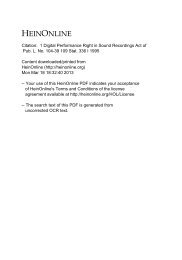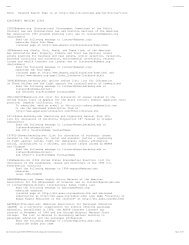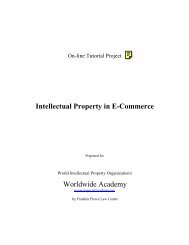BIEDERMANN MOTECH GMBH and Depuy Spine, Inc, Plaintiffs
BIEDERMANN MOTECH GMBH and Depuy Spine, Inc, Plaintiffs
BIEDERMANN MOTECH GMBH and Depuy Spine, Inc, Plaintiffs
Create successful ePaper yourself
Turn your PDF publications into a flip-book with our unique Google optimized e-Paper software.
phrases "the receiver member having ... an inner hollow spherically shaped portion" <strong>and</strong> "compression<br />
member for exerting a force." These four terms are essentially the same terms as were interpreted in the<br />
Order which denied <strong>Plaintiffs</strong>' Motion for Preliminary Injunction. (Order of Jan. 17, 2007, at 7.) The Court<br />
will use <strong>Plaintiffs</strong>' more succinct phrases in lieu of those of Allez<br />
It is true that the grounds for claim interpretation have been hoed by several courts before this one. That<br />
does not mean, however, that Allez's arguments are meritless. Previous litigants fighting over different<br />
allegations of infringement may have chosen to emphasize different arguments, based on the facts of the<br />
particular cases or other factors.<br />
In the present case, there are serious deficiencies in how the claims are drafted. The parties have not<br />
suggested that the significance of these deficiencies was addressed in the previous litigation. Claim 1 recites<br />
"two holes," yet the word "holes" appears nowhere in the rest of the patent application. Id. The same<br />
deficiency afflicts claims 3-6, as they depend from claim 1 without clarifying the word "holes." Claims 2<br />
<strong>and</strong> 7 recite "slits" without providing an antecedent basis for them. Claim 4 depends from claim 1 <strong>and</strong> refers<br />
to "the radii of the hollow spherically shaped portions," yet claim 1 describes only one hollow spherically<br />
shaped portion. Thus, it appears that claim 4 ought to depend from claim 3 which recites a second hollow<br />
spherically shaped portion, rather than depending from claim 1. A similar defect afflicts claim 6, which<br />
depends from claim 1 <strong>and</strong> refers to "said hollow cylindrical portion," a feature which is introduced in claim<br />
5. Thus, it appears that claim 6 ought to depend from claim 5 rather than claim 1. On top of all this, claim 1<br />
has an obvious typographical error where it reads, "two holes for receiving a rod 916)," where the numerical<br />
reference should read "(16)" instead; i.e., the patent attorney forgot to hit the shift key when typing the left<br />
parenthesis <strong>and</strong> failed to carefully proofread her work. In other words, every claim of this patent suffers,<br />
directly or indirectly, from at least one drafting defect. Allez has identified other purported ambiguities in<br />
the second <strong>and</strong> fourth terms. This Order discusses whether <strong>and</strong> how these maladies apparently caused by<br />
sloppy drafting will be cured through claim construction. This is a case where poor drafting of the patent<br />
has made the process of claim construction unnecessarily difficult. See Honeywell, <strong>Inc</strong>. v. Victor Co. of<br />
Japan, Ltd., 298 F.3d 1317, 1323 (Fed.Cir.2002).<br />
A. Two Holes for Receiving a Rod<br />
The specification teaches two slits in the receiver member for receiving a rod, indicated in the drawings,<br />
specification, <strong>and</strong> claims by numeric references 12 <strong>and</strong> 13. ('678 patent, at col. 2 ll. 42-52.) The specification<br />
also teaches that the compression member has two slits for receiving the rod, which line up with the slits in<br />
the receiver member. The compression member slits are indicated in the drawings, specification, <strong>and</strong> claims<br />
by numeric references 20 <strong>and</strong> 21. ('678 patent, at col. 3 ll. 5-11.) Claims 2 <strong>and</strong> 7 reference the slits of the<br />
receiver member <strong>and</strong> the compression member, respectively. ('678 patent, cl. 2, at col. 4 ll. 28-30; '678<br />
patent, cl. 7, at col. 4 ll. 51-52.)<br />
<strong>Plaintiffs</strong> face a serious problem in that claim 1 recites "holes," a phrase which does not appear elsewhere in<br />
the patent: "said receiver member being provided with two holes for receiving a rod [ (16) ]." ('678 patent,<br />
cl. 1, at col. 4 ll. 28-30; Several questions are raised: Is the choice of word "holes" a mistake? What does<br />
"holes" mean in the context of this patent? Is this meaning of holes supported by the specification? As the<br />
claims are literally drafted, how does "holes" interact with the "slits" recited in claims 6 <strong>and</strong> 7? Are there<br />
any other problems with defining "holes" in such a way?<br />
As a preliminary matter, it certainly appears that the use of the word "holes" was a drafting error. It appears






